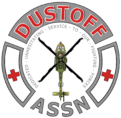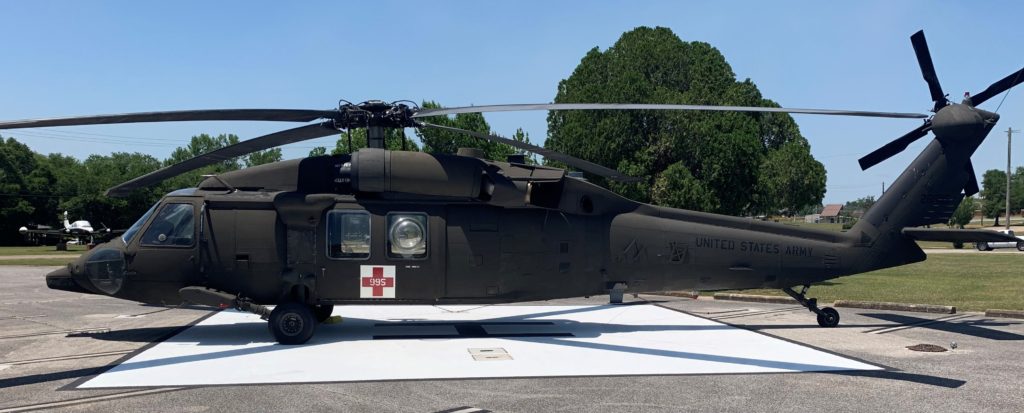By: Cpt. Marjorie A. Evans and Sgt. 1st Class Billy Raines
Fort Rucker, Alabama—An unveiling ceremony for the Medical Evacuation (MEDEVAC) Aircraft 26995 Capability Development Tool was hosted on Fort Rucker, Alabama, on April 14, 2022 by the Medical Evacuation Concepts & Capabilities Division (MECCD), Medical Capability Development Integration Directorate (MED CDID). The historic occasion showcased the only MEDEVAC Blackhawk on display in the Department of Defense.
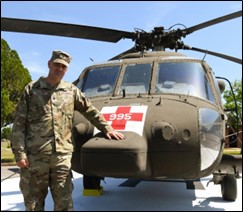

“This project is nearly two years in the making and this will help the U.S. Army improve patient care in current and future systems,” said Col. Samuel L. Fricks, Chief, MECCD.
MEDEVAC Aircraft 995 was one of only 34 HH-60Ls made by Sikorsky as the Army’s first production aircraft utilizing a partial 1553 data-bus architecture with a single monochrome Multi-Function Display. Prior models were “retrofitted,” making this the first rotary-wing aircraft after the UH-1 Iroquois, better known as the “Huey,” to be purpose-built for the MEDEVAC mission. The HH-60Ls are the predecessor to today’s medical equipment suite with innovations such as onboard oxygen generation and a modular patient handling system.
This aircraft’s first flight was in 2004, and it spent the majority of its service with Charlie Company 2-4 Combat Aviation Brigade at Fort Hood and C Co 2-501 CAB at Fort Bliss, Texas. It served two combat tours in Iraq during Operation Iraqi Freedom and two tours in Afghanistan during Operation Enduring Freedom. In December of 2021, 995 was transported to its final mooring with MECCD at Fort Rucker, Alabama.
All HH-60L models have been decommissioned or sold to other government agencies. This is the last surviving HH-60L in the Army.
Fricks hosted the event at Fort Rucker and provided opening remarks. “Ever since mankind has taken to the skies, there has been a bond that forms between the aircraft and the crews who fly them.” He spoke about the flood of pictures he received and stories past crewmembers recounted while serving with this aircraft. “Today, we are privileged to have some former crew members with us.” Fricks, at the ceremony, asked them to stand and be recognized for their service.
The aircraft will now serve as a capability tool to create and evaluate new concepts and emerging innovations in future MEDEVAC equipment designs. Developers will be able to visualize these technologies on the aeromedical platform itself without the need for external agency support. Additionally, the aircraft will serve as a training aid for the School of Army Aviation Medicine to support aircraft systems training for future aircrew members.
Chaplain (Col.) Robert J. Crowley, senior command chaplain, provided the invocation citing, “Indelible recognition of the Golden Hour missions [995] flew with our patriots that it transported to care and safety.” He asked those present to remember the front lines of freedom, truly capturing the MEDEVAC’s spirit to go into contested locations to save lives without hesitation willingly.
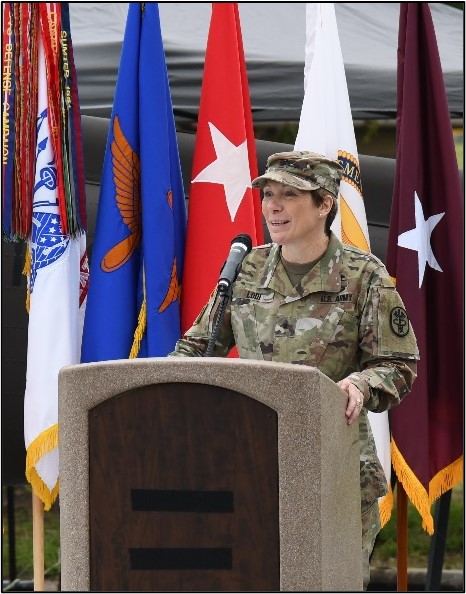

Brig. Gen. Paula C. Lodi, deputy commander (support), U.S. Army Medical Command was the keynote speaker representing the Office of the U.S. Army Surgeon General. She recounted the distinguished service of Maj. Charles Kelly, known as the father of DUSTOFF, who was killed in action during a MEDEVAC mission in Vietnam. When ordered off the enemy-contested landing zone, he defied orders with his legendary words, “When I have your wounded.” Lodi commemorated this occasion as “A unique moment in time to simultaneously honor MEDEVAC’s storied past and critical future. In fact, reminding ourselves of the past is a prologue to what is possible… Today is about [the MEDEVAC] of tomorrow, who will courageously dedicate themselves to the MEDEVAC mission.”
Also in attendance were many distinguished guests and friends of the aeromedical evacuation community, including Maj. Gen. David J. Francis, Commanding General, U.S. Army Aviation Center of Excellence, Jay Harmon, Deputy to the Commanding General, U.S. Army Medical Center of Excellence, Brig. Gen. Andrew C. Hilmes, Commanding General, U.S. Army Combat Readiness Center, Chief Warrant Officer 5 Michael L. Lewis, Aviation Branch Chief Warrant Officer, Command Sgt. Maj. James D. Wilson, Aviation Branch Command Sgt. Maj and former crewmembers of aircraft 995.


Both Francis and Lodi performed the momentous ribbon cutting. They cut two ribbons signifying the inherent shared responsibility for the aeromedical evacuation mission: Army aviation blue and Army medicine maroon. Both branches are critical to the life-saving mission of MEDEVAC, operating in some of the most contested and austere environments.
In addition to the ribbon-cutting ceremony, MECCD also exhibited current and future ground evacuation platforms, demonstrating first-hand developments to modernize the future MEDEVAC fleet. This demonstrates the move towards the future of medical support on the battlefield similarly to what 995 did in the past. Platforms on display included the current M997A3 Field Litter Ambulance (FLA), Armored Multi-Purpose Vehicle (AMPV) ambulance variant, and the lone prototype of the Joint Light Tactical Vehicle (JLTV) ambulance. Also on display was a one-third scale model of the Multi-Modal Vehicle Interface (MMVI) that will “inform the design of the next patient handling system for the Future Vertical Lift,” stated Fricks.


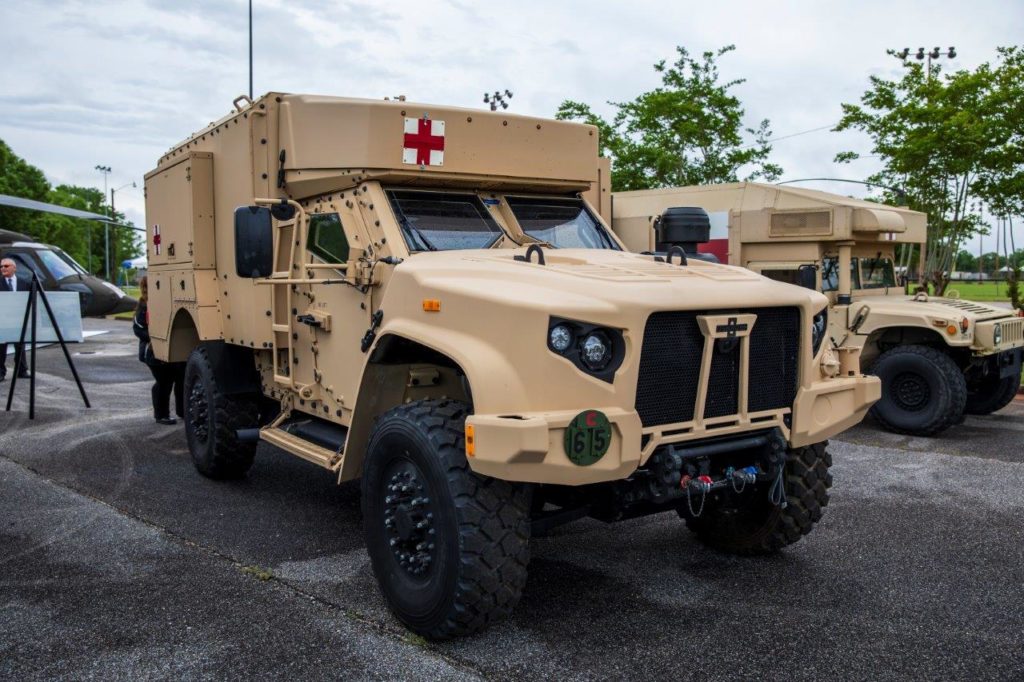

“The past has forged an inextricable link between Army Aviation and Army Medicine… Looking forward to the future, the Army’s focus is on modernization,” Lodi expressed for the aeromedical future. With the unveiling of the 995 HH-60L Capability Development Tool, the MED CDID remains committed to advancing medical and aviation technologies to support the MEDEVAC operations of tomorrow. MECCD is excited to use this platform for continued innovation and ensure operational reach to conserve our fighting force.
On behalf of MECCD, Fricks, would like to extend a special thanks to the organizations that helped make this remarkable occasion a reality. US Falcon team members were instrumental in acquiring, restoring, and delivering 995. US Falcon supports maintenance efforts at Joint Base Langley-Eustis, Virginia, where the aircraft was housed prior to transport to Fort Rucker.
The Fort Rucker Aviation Center Logistic Command reassembled, serviced, and assisted with 995’s final placement upon arrival. Finally, this would not have been possible without the DUSTOFF Association, which enabled the construction of 995’s permanent mooring pad at Fort Rucker, Alabama. Thank you all for the incredible support you have provided to ensure this incredible resource is available to our Soldiers and capability developers
